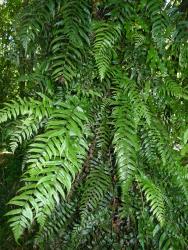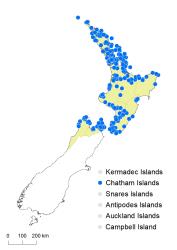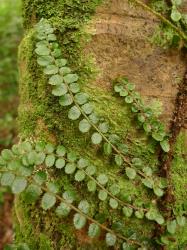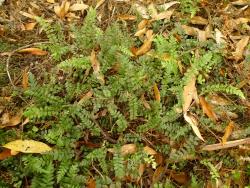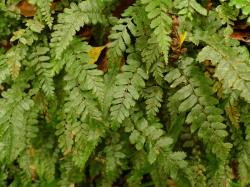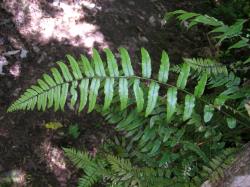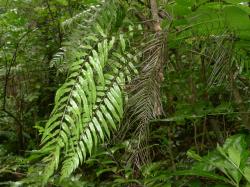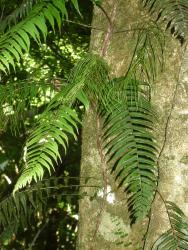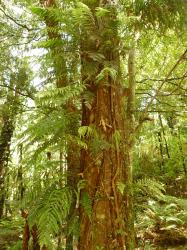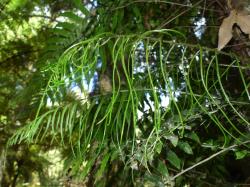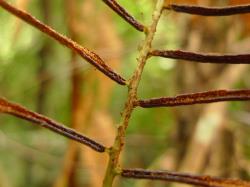- ≡ Lomaria filiformis A.Cunn., Companion Bot. Mag. 2: 263 (1837)
- ≡ Stenochlaena heteromorpha J.Sm., J. Bot. (Hooker) 4: 149 (1841) nom. illeg., nom. nov. pro Lomaria filiformis A.Cunn. 1837
- ≡ Lomariopsis heteromorpha (J.Sm.) T.Moore, Index Fil. xvii (1857) nom. illeg.
- ≡ Spicanta filiformis (A.Cunn.) Kuntze, Revis. Gen. Pl. 2, 821 (1891)
- ≡ Struthiopteris filiformis (A.Cunn.) Ching, Sunyatsenia 5: 243 (1940)
- ≡ Icarus filiformis (A.Cunn.) Gasper & Salino in Gasper et al., Phytotaxa 275: 211 (2016)
- = Lomaria propinqua A.Cunn., Companion Bot. Mag. 2: 364 (1837)
- = Lomaria pimpinellifolia Hook.f., London J. Bot. 3: 412 (1844) – as L. pimpinellaefolia
- = Lomariopsis hugelii C.Presl, Epimel. Bot. 263 (1851)
- ≡ Stenochlaena hugelii (C.Presl) Fée ex Underw., Bull. Torrey Bot. Club 33: 46 (1906)
Rhizomes long-creeping and climbing, bearing scales. Rhizome scales linear to narrowly ovate, 2.5–6 mm long, 0.2–0.5 mm wide, chestnut-brown, concolorous, or bicolorous with paler margins. Fronds trimorphic. Juvenile sterile fronds 35–380 mm long, borne on terrestrial rhizomes; adult sterile fronds 225–760 mm long, borne on climbing rhizomes; fertile fronds 170–610 mm long, borne on climbing rhizomes, usually c. 2 m above ground, usually shorter and wider than adult sterile fronds on the same plant. Juvenile sterile fronds. Stipes 5–120 mm long, red-brown proximally, yellow-brown distally, scaly. Rachises yellow-brown, grooved adaxially, scaly and hairy. Laminae pinnate, linear to narrowly elliptic, reducing to a very short apical segment, 30–315 mm long, 6–60 mm wide, similar colour on both surfaces, herbaceous, bearing a few scales and hairs. Pinnae in 9–25 pairs, widely spaced, ovate or elliptic or oblong, straight, gradually reducing to the lamina base; the longest pinnae near the middle, 3–42 mm long, 1.5–10 mm wide, apices obtuse to acuminate, margins deeply serrate, bases stalked. Adult sterile fronds. Stipes 30–170 mm long, red-brown proximally, yellow-brown distally, bearing narrowly ovate chestnut-brown scales. Rachises yellow-brown, grooved adaxially, bearing linear to narrowly ovate chestnut-brown scales, and white or pale brown hairs to 0.5 mm long. Laminae pinnate, narrowly elliptic, tapering to a very short apical segment, 200–620 mm long, 45–210 mm wide, similar colour on both surfaces, herbaceous to coriaceous, bearing white or pale brown hairs on costae and laminae. Pinnae in 20–30 pairs, closely spaced, narrowly ovate or narrowly triangular, rarely with small acroscopic and basiscopic auricles, straight or slightly falcate, gradually reducing to the lamina base; the longest pinnae at or below the middle, 25–115 mm long, 5–18 mm wide, apices acuminate, margins serrate, bases stalked; the basal pinnae opposite. Veins free. Fertile fronds. Stipes 40–270 mm long. Laminae 135–425 mm long, 75–300 mm wide, scaly. Pinnae in 20–30 pairs, linear, straight, the longest 50–175 mm long, 0.5–2.5 mm wide, fertile throughout. Sori and indusia in one row either side of costa, continuous along the length of the distal pinnae.
Blechnum filiforme is readily distinguished by its long-creeping and climbing rhizomes, its trimorphic fronds, its free veins, and continuous sori. It is one of the few high-climbing ferns in New Zealand, and the country’s only climbing species of Blechnum. It initially creeps in tangled masses on the ground and over rock before growing up a tree trunk. The juvenile fronds produced on the ground are short, linear and have stalked, deeply serrate, obtuse pinnae. As the plant climbs, larger adult fronds are produced, with elongated and acuminate pinnae. Fertile fronds are usually produced c. 2 m above ground level, with long, very narrow pinnae. The fertile fronds are generally shorter and wider than the adult sterile fronds. Eventually the fern may completely smother the trunk of the host tree.
North Island: Northland, Auckland, Volcanic Plateau, Gisborne, Taranaki, Southern North Island.
South Island: Western Nelson, Sounds-Nelson.
Three Kings Islands, Chatham Islands.
Altitudinal range: 0–780 m.
Blechnum filiforme occurs on the Three Kings Islands and in coastal and lowland areas of the North Island from Te Paki to Wellington, extending locally into montane areas. It is rare in the central North Island and much of Gisborne and Hawke’s Bay. It grows from near sea level to 780 m on Mt Ngongotahā, Rotorua, but is uncommon above c. 500 m. In the South Island it is found only in coastal and lowland districts from Cape Farewell to the Marlborough Sounds, reaching 400 m near Nelson. It has also been recorded from the Chatham Islands.
Blechnum filiforme is a high-climbing fern found in podocarp and broadleaved forest, or more rarely in beech forest, coastal scrub and under mānuka or kānuka. It grows on river terraces, hillsides, banks, and in gullies. Juvenile plants are found creeping on the ground and over rocks and logs, before climbing a variety of forest trees and tree ferns.
2n = c. 66 (Chambers 1954).
Lomariopsis hugelii was described by Presl (1851) from a specimen collected by Hügel in New Zealand. Although Brownlie (1959) examined a specimen at K and identified it as Blechnum filiforme, Presl’s protologue specifically cited a specimen “in Herb. Mus. pal. vind.”. The specimen in W (078561) is therefore the holotype, and the specimen in K seen by Brownlie is probably an isotype, although it has not been seen by us. Holttum (1968) also saw a duplicate in the Presl Herbarium at PRC but confirmed that the holotype is the specimen in W.
The name Blechnum reptans was published by Luerssen (1871), apparently based on the unpublished name Osmunda reptans used by Solander and cited by Forster (1786, p. 93) as a nomen nudum. However, Luerssen also noted that “According to Brackenridge’s observations, the rhizome climbs up to a height of 20–30 feet on the trees”. This is an adequate description to validate B. reptans Luerss. as a new name. Nevertheless, the names Lomaria filiformis, Blechnum filiforme, Lomaria propinqua, L. pimpinellifolia, Stenochlaena heteromorpha and S. feejeensis Brack. were all cited in synonymy, and Blechnum reptans is therefore an illegitimate and superfluous name including two different taxa from New Zealand and Fiji. Luerssen cited a specimen collected by Brackenridge in Fiji, but also included New Zealand in the distribution. Christensen (1905–1906) treated B. reptans as a synonym of B. filiforme, but it is better regarded as an illegitimate name for a species of Stenochlaena in Fiji.



